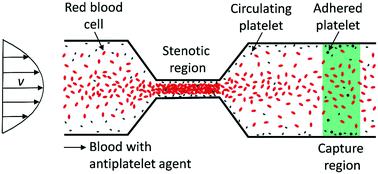Our official English website, www.x-mol.net, welcomes your feedback! (Note: you will need to create a separate account there.)
Microfluidic assay of antiplatelet agents for inhibition of shear-induced platelet adhesion and activation
Lab on a Chip ( IF 6.1 ) Pub Date : 2020-11-13 , DOI: 10.1039/d0lc00756k Shekh Mojibur Rahman 1 , Vladimir Hlady
Lab on a Chip ( IF 6.1 ) Pub Date : 2020-11-13 , DOI: 10.1039/d0lc00756k Shekh Mojibur Rahman 1 , Vladimir Hlady
Affiliation

|
We have developed a microfluidic system to perfuse whole blood through a flow channel with an upstream stenotic region and a downstream protein capture region. This flow-based system was used to assay how effectively antiplatelet agents suppress shear-induced platelet adhesion and activation downstream of the stenotic region. Microcontact printing was used to covalently attach one of three platelet binding proteins [fibrinogen, collagen, or von Willebrand factor (vWf)] to the surface of the downstream capture region. Whole blood with an antiplatelet agent was transiently exposed to an upstream high wall shear rate (either 4860 s−1 or 11 560 s−1), and subsequently flowed over the downstream capture region where the platelet adhesion was measured. Several antiplatelet agents (acetylsalicylic acid, tirofiban, eptifibatide, anti-vWf, and anti-GPIbα) were evaluated for their efficacy in attenuating downstream adhesion. Following antibody blocking of vWf or GPIbα, downstream platelet activation was also assessed in perfused blood by flow cytometry using two activation markers (active GPIIb/IIIa and P-selectin). Acetylsalicylic acid demonstrated its inability to diminish shear-induced platelet adhesion to all three binding proteins. GPIIb/IIIa inhibitors (tirofiban and eptifibatide) significantly reduced platelet adhesion to fibrinogen. Antibody blocking of vWf or GPIbα effectively diminished platelet adhesion to all three capture proteins as well as platelet activation in perfused blood, indicating an essential role of vWf–GPIbα interaction in mediating shear-induced platelet aggregation.
中文翻译:

抗血小板剂的微流控测定抑制剪切诱导的血小板粘附和活化
我们已经开发出一种微流体系统,可以通过具有上游狭窄区域和下游蛋白质捕获区域的流道灌注全血。该基于流动的系统用于分析抗血小板药如何有效抑制剪切诱导的血小板粘附和狭窄区域下游的活化。使用微接触印刷将三种血小板结合蛋白[纤维蛋白原,胶原或血管性血友病因子(vWf)]中的一种共价连接到下游捕获区域的表面。将具有抗血小板剂的全血瞬时暴露于上游的高壁剪切速率(4860 s -1或11 560 s -1),然后流过下游捕获区域,在该区域捕获血小板粘附。评估了几种抗血小板药(乙酰水杨酸,替罗非班,依替巴肽,抗vWf和抗GPIbα)在减弱下游粘附方面的功效。抗体阻断vWf或GPIbα后,还使用两种激活标记(活性GPIIb / IIIa和P-选择素)通过流式细胞仪评估了灌注血液中的下游血小板激活。乙酰水杨酸证明其不能减少剪切诱导的血小板对所有三种结合蛋白的粘附。GPIIb / IIIa抑制剂(替罗非班和依替巴肽)显着降低了血小板对血纤蛋白原的粘附。抗体对vWf或GPIbα的阻断可有效减少血小板与所有三种捕获蛋白的粘附以及灌注血液中的血小板活化,
更新日期:2020-12-10
中文翻译:

抗血小板剂的微流控测定抑制剪切诱导的血小板粘附和活化
我们已经开发出一种微流体系统,可以通过具有上游狭窄区域和下游蛋白质捕获区域的流道灌注全血。该基于流动的系统用于分析抗血小板药如何有效抑制剪切诱导的血小板粘附和狭窄区域下游的活化。使用微接触印刷将三种血小板结合蛋白[纤维蛋白原,胶原或血管性血友病因子(vWf)]中的一种共价连接到下游捕获区域的表面。将具有抗血小板剂的全血瞬时暴露于上游的高壁剪切速率(4860 s -1或11 560 s -1),然后流过下游捕获区域,在该区域捕获血小板粘附。评估了几种抗血小板药(乙酰水杨酸,替罗非班,依替巴肽,抗vWf和抗GPIbα)在减弱下游粘附方面的功效。抗体阻断vWf或GPIbα后,还使用两种激活标记(活性GPIIb / IIIa和P-选择素)通过流式细胞仪评估了灌注血液中的下游血小板激活。乙酰水杨酸证明其不能减少剪切诱导的血小板对所有三种结合蛋白的粘附。GPIIb / IIIa抑制剂(替罗非班和依替巴肽)显着降低了血小板对血纤蛋白原的粘附。抗体对vWf或GPIbα的阻断可有效减少血小板与所有三种捕获蛋白的粘附以及灌注血液中的血小板活化,



























 京公网安备 11010802027423号
京公网安备 11010802027423号